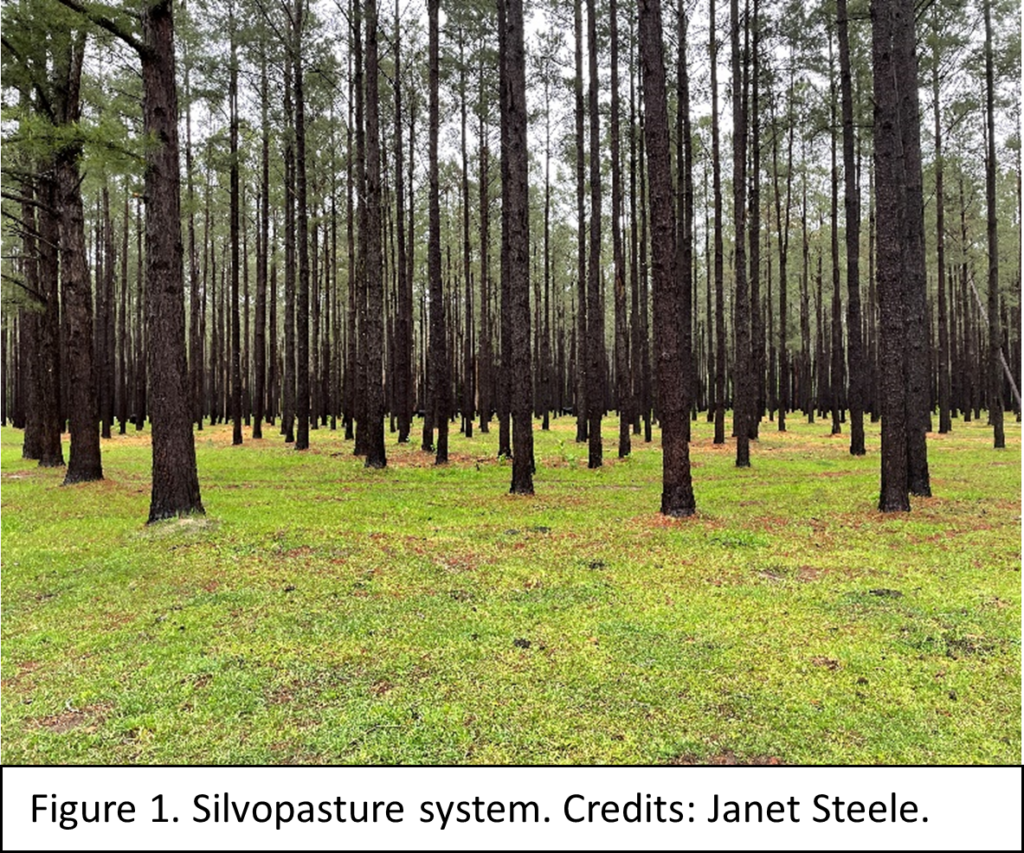Submitted by:
Janet Steele, CUCES
Liliane Silva, CU Assistant Professor and CUCES Forages Specialist
Silvopasture is a system that integrates forage, livestock, and trees (Figure 1).

It is an old practice that is increasing due to the potential agronomic, environmental, economic, and social benefits that silvopasture systems can offer. These benefits include but are not limited to, increased biodiversity, soil health and livestock responses, enhanced aesthetics, and diversification of income for farmers.
Silvopasture systems can be created either by thinning existing timber stands or by
planting trees in existing pasture or in newly established areas. In this context, the choice of forage should be considered based on local climate and topography conditions, soil type, and operation goals, among others. Establishing a silvopasture system requires proper planning and understanding of the needs and requirements of each component of the system (forage, livestock, tree) and their interrelationships with the ecosystem as well.
Establishment of Woodland Component
The forestry component of silvopasture can be established through two methods: planting a new stand or managing an existing stand. New stand establishment can occur on fallow agricultural land, hay fields or pastures, and cutover timberland. A primary consideration for these different sites is the mechanical or chemical preparation treatments required before tree planting. These may include:
• Pastures and Hayfields – Scalping of improved forage grasses
• Agricultural Fields – Ripping or subsoiling of plow pan/hardpan
• All Sites – Herbicide applications to control competition (grasses, broad leaf weeds, and woody and shrubby vegetation on cutovers)
Another pre-establishment consideration is soil pH, which may need to be adjusted for the tree species selected (optimum of 5-5.5 for longleaf and up to 6.0 for loblolly). Finally, residual chemicals used for crop production may require that an agricultural site be laid out up to 1 year before planting tree seedlings.
Most silvopasture systems in the southeast utilize pine species. In South Carolina, this is most often longleaf or loblolly pine. The planting design can be done using two methods. The first is a double row of trees with a forage alley between rows. Tree seedlings are planted at 8′ to 10′ between rows and 4′ to 8′ between trees within rows with 30 to 40-foot alley between the sets of rows. This design results in 200 to 400 trees per acre. Planting in an east-west direction maximizes sunlight on forage strips. The other planting option is a wide block planting [ex. 12′ by 12′ spacing to establish 300 trees per acre]. This design limits the producer’s ability to harvest hay. Genetically improved tree seedlings developed for fewer limbs and improved stem form should be considered for this planting option. Livestock should be excluded from new stands for the first 3 to 6 years. The terminal buds need to be above browsing height, and the trees sturdy enough to withstand rubbing and trampling before animals are introduced.
The other method for establishing the tree component in silvopasture is to manage an existing timber stand. Reducing the stand density through thinning to the desired density based on the sunlight needed for successful forage establishment and production is often required. If the stand is being thinned for the first time, this is traditionally a 3rd or 4th row thinning, with additional removals within the residual rows. A professional forester should mark subsequent thinnings to ensure residual crop trees with the best timber quality will be left while meeting stand density requirements. Depending on the producer’s selected forage, a residual basal area of 40-60 ft2/acre is usually recommended.
Management of the tree component in a silvopasture system can include prescribed burning to reduce hazardous fuels, improve forages for livestock and wildlife species, and prune lower limbs. Mechanical pruning is a labor-intensive management activity required to maintain stem quality on crop trees and create knot-free wood. Widely spaced trees and those sides of trees exposed to sunlight will develop more and larger limbs. Pruning also raises the canopy to allow more sunlight to reach the forages. Finally, herbaceous weed control is often required in the understory of the timber to enhance forage production.
